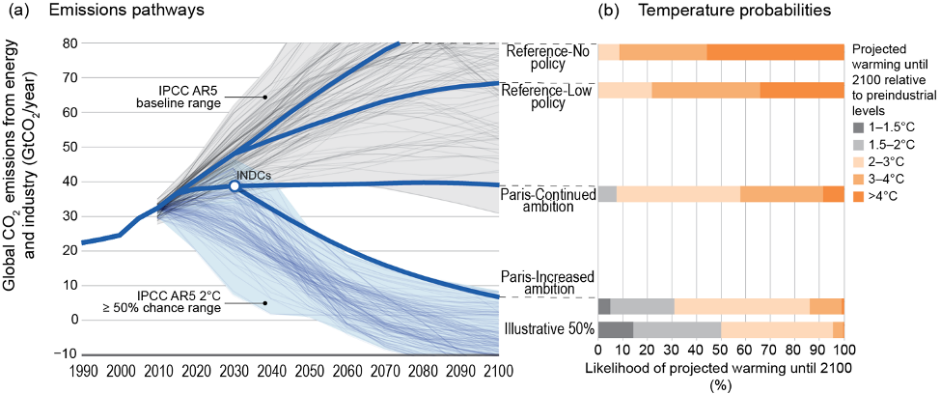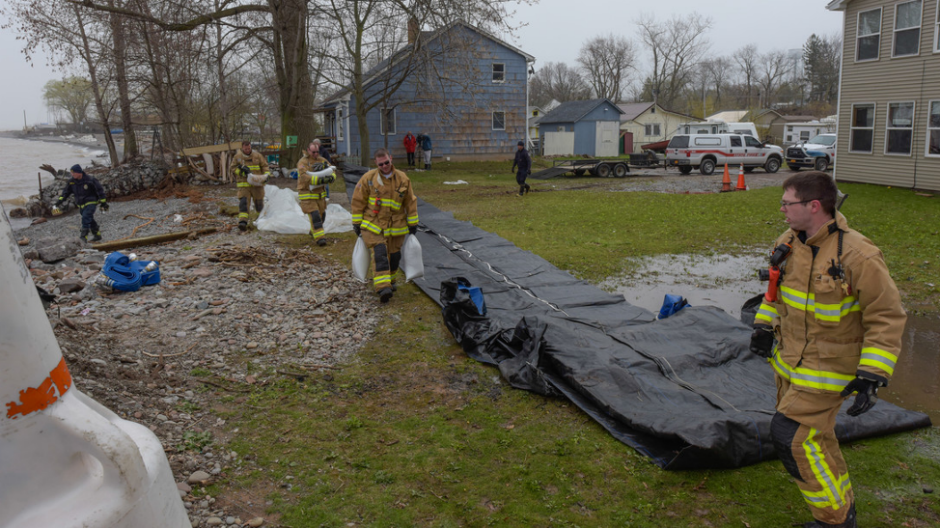Sherif Goubran is an architect and PhD candidate in the Individualized Program (INDI) at Concordia University. A Vanier scholar, he also has an MASc in building engineering from Concordia and a BS in architecture from the American University in Cairo. He co-leads a food preservation project on campus and represents graduate students on a number of university committees.
Blog post
Climate change: mitigation, adaptation and the role of design
 This panel, “Emission Pathways,” is an adapted figure provided by Jae Edmonds.
This panel, “Emission Pathways,” is an adapted figure provided by Jae Edmonds.
We usually see charts and graphs of different global warming scenarios, just like the one above.
One clear conclusion is that we should be putting a lot of effort and funding toward further reducing our carbon emissions. This is what many people commonly refer to as climate change mitigation — or approaches aimed at reducing emission sources and greenhouse gases.
But another important observation from this chart is that, even in the most optimistic scenario — referred to as IPCC AR5 2C in the figure above — we have about a 50 per cent chance of keeping warming below the 2°C threshold by 2100.
In fact, another study estimates that we have a 5 per cent chance that the global temperature increase will be less than 2°C, and that the average expected increase will be 3.2°C relative to preindustrial levels.
Of course, there are many discussions on whether the 2°C threshold is scientifically the tipping point in our climate — you can learn more about these discussions in The Conversation post by David Titley. However, we know from the Intergovernmental Panel on Climate Change (IPCC) that the higher the temperature increase the larger the risks.
If we know that global warming is progressing (steadily but surely), that we have a very small chance to keep it under control and that there are significant risks involved, we should be making sure we are adapting to the expected changes.
We should be getting ready!
Adaptation can be defined as “adjustments in natural or human systems in response to actual or expected climatic stimuli or their effects, which moderates harm or exploits beneficial opportunities.” Natural Resources Canada further clarifies that “adaptation can be reactive, occurring in response to climate impacts, or anticipatory, occurring before impacts of climate change are observed. In most circumstances, anticipatory adaptations will result in lower long-term costs and be more effective than reactive adaptations.”
We also know that adaptation strategies, which aim to reduce vulnerabilities and social or economic damages, are closely linked to sustainable development agendas such as the Sustainable Development Goals.
But here is the dilemma …
In a recent report published by the Climate Policy Initiative, they estimated that the annual cash flows into climate finance were $579 billion in 2018 — decreasing from $612 billion in 2017. These funds are available to both public and private actors. Most of the funds — 93 per cent — went toward mitigation efforts, including investments in renewable energy, low-carbon transport and energy efficiency.
That leaves only 7 per cent — or $42 billion — for adaptation or combined mitigation and adaptation efforts. While the $42 billion represents an increase from 2016 levels, it constitutes less than 25 per cent of the $180 billion estimated annual adaptation costs. That number that is projected to increase to $300 billion annually by 2030.
These adaptation funds address issues such as disaster risk management, water and waste, and industry and infrastructure. What is also alarming is that none of the adaptation funds came from private actors — such as individuals or corporate actors — and grants primarily funded the adaptation initiatives.
But maybe the funds' distribution is not that surprising after all. In a news feature recently published by Nature, Megan Bowman, a climate finance and regulation researcher at King’s College London, explains, “Renewable-energy projects now have a pretty good rate of return, generally speaking, but adaptation projects — building sea walls and infrastructure upgrades — it’s harder to find a business case for a private-sector player.”
Scholars in finance, including Concordia researchers, will tell you that most organizations, both public and private, have not fully measured their exposure to climate change-induced risks; thus, they do not consider the possible opportunities and costs related to these risks. While the increasing frequency of extreme climate change-related events will make those risks more visible, it might be already too late to adapt our cities, industries and economy.
Let’s take sea-level rise and flooding as an illustrative example
Flooding is becoming ever more frequent and extreme. We experienced this in Montreal during the last flood season. The sea level is climbing at about 3.6 millimetres per year. Currently, many governments are funding mega-projects to protect their shores.
However, much of our response to water rise and flooding risks seems to fit within the disaster management category. A famous example is the sandbagging of shorelines.
 Photo by Peter Borys
Photo by Peter Borys
Megan Bowman is right that currently there is no “business plan” for the private sector to fund sea walls or emergency responses to flooding.
Designers have a vital role to play …
Adaptation projects geared toward water level increases and flooding risks do not have to look like dull concrete blocks, walls or ditches. They don’t have to mean reducing the quality or beauty of our shorelines, and they certainly cannot continue to be temporary emergency response solutions.
In her article, Kristina Hill explores coastal infrastructures’ typologies for adapting to the sea-level rise. The article highlights that static walls constitute only a quarter of the options available — where static and dynamic landforms, such as mounds, beaches and marches, and dynamic walls, such as tide gates and movable surge barriers, populate the rest of the solution space for this climate risk.
By looking at the winning entries for an international design competition organized by the San Francisco Bay Commission for Development and Conservation (BCDC), Hill was able to show that most of the entries focused on static solutions and that no entries explored the category of dynamic landforms.
From the precedents that are available, we can see that exploring Hill’s solution space — using design as a method — presents many opportunities.
Take, for example, the Seattle seawall. This static sea-wall, while protecting the city, offers habitat and protection for young salmon. The project also revitalized the city’s waterfront. This project falls under the category of approaches often named living shorelines, which combine knowledge from climate science and ecology to develop synergistic solutions that address sea-level rise and biodiversity risks by including hybrid environmental and man-made features.
In Toronto, the revitalization of the Port Lands and its protection project combines flood mitigation strategies with the creation of a new island, parks, roads, bridges and development projects. The project, which will protect more than 300 hectares of land from flooding, also presents business opportunities for developers and a new, more naturalized destination for the city.
Another famous example is the Rabalder Park in Roskilde, Denmark. The park includes a drainage canal that is also a skateboard park. Through design, the project, which won several awards, moved from being a simple infrastructure into a multi-functional recreation area.
Other ideas that are being developed combine electric generation technologies with flood control infrastructures or use material sciences to create systems that don’t have to depend on electricity or manpower to respond to floods and rising water levels. Of course, the field of material sciences has a lot to offer in the adaptation and mitigation of climate change hazards.
The way forward
So, while a concrete barrier by itself might not be an attractive business plan, designers must develop ideas that tap into the opportunities that adaptation strategies offer to our cities and environment, as well as to private actors.
It is only through these approaches that we can start to understand the needed balance between adaptation and mitigation in different locations and contexts.
About the author


